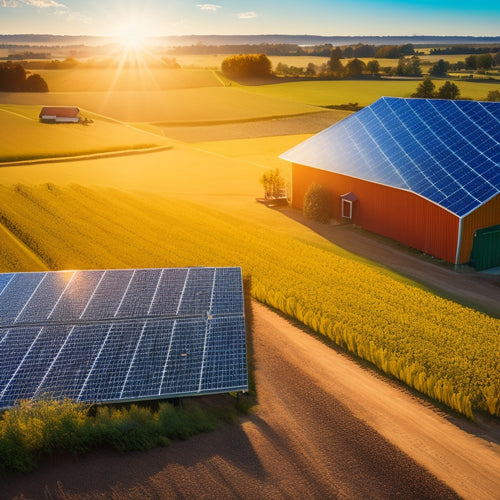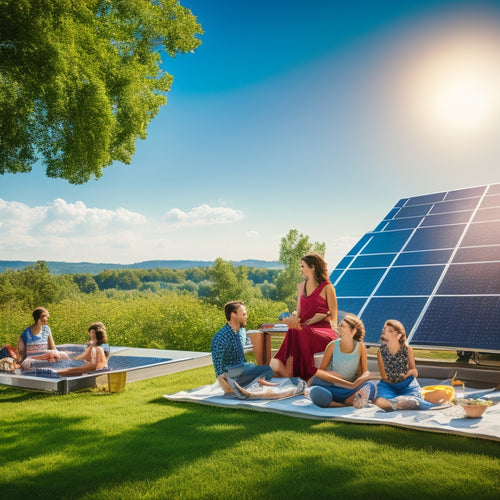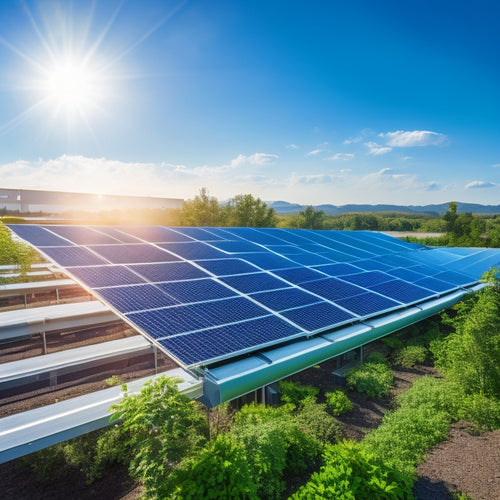
What You Need to Know About Solar Power for Homes Price
Share
You're about to invest in a solar power system for your home, but before you do, understanding the price is essential, with total system costs ranging from $15,000 to $30,000 or more, depending on the type and quality of equipment, installation complexity, and local incentives. The cost per watt is a significant metric, averaging around $2.95, and system size is key, with typical residential systems ranging from 3 kW to 10 kW. As you weigh your options, consider factors like labor costs, market trends, and incentives, and investigate the benefits of high-efficiency panels, battery backup systems, and rebate programs - there's more to unveil about making the most of your solar power investment.
Key Takeaways
- Solar panel costs vary by type, with monocrystalline being higher efficiency and higher cost, and polycrystalline being lower efficiency and lower cost.
- The average cost of a solar installation is around $2.95 per watt, with system size being a key factor in determining overall cost.
- High-efficiency panels may cost more upfront but can reduce overall costs by requiring fewer panels, while low-efficiency panels may increase installation costs.
- Battery backup systems can add $5,000 to $15,000+ to the overall cost, depending on capacity and quality, and are crucial for energy storage during nighttime or outages.
- Federal, state, and local incentives can significantly reduce the overall cost of a solar power system, making it essential to research and explore available programs.
Understanding Solar Panel Costs
When evaluating solar power for your home, understanding the costs involved is essential to making an informed decision. The cost of solar panels varies depending on the type and quality of the panels.
There are two main solar panel types: monocrystalline and polycrystalline. Monocrystalline panels are more efficient but also more expensive, while polycrystalline panels are less efficient but more affordable.
You'll also need to take into account the cost of inverters, mounting hardware, and installation. The total cost can range from $15,000 to $30,000 or more, depending on the size of your system.
Fortunately, there are financing options available to help offset the upfront cost. You can choose to purchase the system outright, finance it through a loan, or lease the system from a third-party provider.
Many solar companies also offer power purchase agreements, which allow you to pay for the electricity generated by the system rather than the system itself.
Factors Affecting Solar Power Pricing
As you examine financing options and assess the upfront costs of solar power, it's equally important to take into account the factors that influence solar power pricing. One key factor is the cost of equipment, which can vary depending on the quality and efficiency of the solar panels and inverters.
Labor costs are another crucial factor, as installation complexity and local labor rates can impact pricing. In addition, market trends and demand for solar power can drive prices up or down, making it essential to stay informed about current market conditions.
You should also consider the impact of local and national incentives, such as tax credits and rebates, which can greatly reduce the overall cost of solar power.
Moreover, the size and complexity of your solar panel system will also influence pricing, as larger systems require more equipment and labor. By understanding these factors, you can make informed decisions about your solar power investment and steer through financing options that work best for your budget and energy needs.
Average Cost of Solar Installation
When you're considering solar power for your home, you'll want to understand the average cost of solar installation.
You'll find that system size matters, as larger systems require more panels and equipment, increasing the overall cost.
The cost per watt is a key metric, as it helps you compare prices between different systems and providers.
System Size Matters
You're likely wondering what size solar panel system your home needs, and how that affects the overall cost. The system capacity you require depends on your energy needs, installation location, and energy independence goals. A larger system will generate more electricity, but it also increases the upfront cost.
To determine the right size, consider your energy usage over the past year. Your installer will assess your energy needs and recommend a system capacity that suits you. Financing options can help make a larger system more affordable, and long-term savings on your electricity bills will offset the initial investment.
Additionally, a larger system will lead to greater environmental impact reduction. Maintenance costs are generally proportional to system size, but modern systems are designed to be low-maintenance. Performance monitoring will guarantee your system operates at peak levels.
With a grid connection, you can sell excess energy back to the grid and offset your energy independence goals. By understanding your energy needs and system capacity requirements, you can make an informed decision on the right solar panel system for your home.
Cost Per Watt
Your solar panel system's cost is heavily influenced by its capacity, so it's natural to wonder about the cost per watt of the installation. This metric is vital for a cost comparison between different systems. The average cost per watt for a residential solar panel system is around $2.95.
However, this cost can vary depending on the watt efficiency of the panels. High-efficiency panels with higher wattage ratings will have a lower cost per watt, while lower-efficiency panels will have a higher cost per watt.
When evaluating different systems, consider the overall wattage and the cost per watt to determine the best value. A system with a higher upfront cost may have a lower cost per watt due to its higher wattage rating, making it a more cost-effective option in the long run.
Conversely, a system with a lower upfront cost may have a higher cost per watt, making it less cost-effective. Understanding the cost per watt is fundamental for making an informed decision when investing in a solar panel system for your home.
Solar Panel System Sizes Matter
How much power does your home actually need? This is an essential question when determining the size of your solar panel system. The size of the system directly impacts the overall cost and performance of your solar power installation. A system that's too small won't generate enough power, while one that's too large will waste resources.
Your energy needs depend on factors like your home's size, energy efficiency, and your energy usage patterns. A typical residential solar panel system ranges from 3 to 10 kilowatts (kW). For example, a 5 kW system can power a medium-sized home with average energy consumption. However, if you have a larger home or high energy demands, you may need a 7 kW or 10 kW system.
Solar panel efficiency and installation location also play a role in system sizing. More efficient panels can generate more power per unit area, reducing the overall system size needed.
Installation location is also vital, as shading, orientation, and local building codes can affect system performance. By accurately evaluating your energy needs and considering these factors, you can determine the best solar panel system size for your home.
Efficiency and Quality Impact Price
As you determine the ideal solar panel system size for your home, it's equally important to take into account the efficiency and quality of the panels themselves, as these factors greatly influence the overall price of the system.
High-efficiency panels generate more power per unit area, reducing the number of panels needed to meet your energy requirements. This can lead to significant cost savings. On the other hand, low-efficiency panels may require more units to achieve the same output, increasing the overall cost.
| Panel Efficiency | Impact on Price |
|---|---|
| High (>20%) | Higher upfront cost, but fewer panels needed, reducing installation and material costs. |
| Medium (18-20%) | Balanced efficiency and cost, suitable for most residential installations. |
| Low (<18%) | Lower upfront cost, but more panels needed, increasing installation and material costs. |
| Premium (>22%) | Highest upfront cost, but maximum energy output and potential long-term savings. |
| Budget (<15%) | Lowest upfront cost, but lowest energy output and potentially higher maintenance costs. |
Battery Backup Systems and Cost
You'll need to evaluate the cost of system components, including the battery bank, inverter, and charger, which can range from $5,000 to $15,000 or more, depending on the capacity and quality of the equipment.
Your backup power options will also impact the overall cost, as you'll need to decide between a DC-coupled or AC-coupled system, each with its own set of benefits and drawbacks.
System Components Cost
The solar power system's brain, the battery backup system, plays a critical role in storing excess energy generated by your solar panels during the day for use at night or during power outages. This system consists of several components that work together to guarantee a seamless power supply.
| Component | Cost Range |
|---|---|
| Battery Bank | $8,000 - $15,000 |
| Charge Controller | $1,000 - $3,000 |
| Inverter/Converter | $2,000 - $5,000 |
| Monitoring System | $500 - $2,000 |
| Installation Labor | $2,000 - $5,000 |
When evaluating the cost of a battery backup system, you'll need to factor in the cost of these components, as well as system maintenance and potential installation challenges. You'll need to decide on the type and size of battery bank, charge controller, and inverter/converter that suit your energy needs. Additionally, you'll need to take into account the cost of labor for installation, which can vary depending on the complexity of the installation and local labor rates. By understanding these costs, you can make an informed decision about investing in a battery backup system for your solar power system.
Backup Power Options
Your solar power system's ability to provide backup power during outages or at night hinges on a reliable battery backup system. This is vital for achieving grid independence and energy security.
With a battery backup system, you can store excess energy generated by your solar panels during the day for use during the night or when the grid is down. This means you can enjoy uninterrupted power supply, even when the grid fails.
When it comes to battery backup systems, you have several options to choose from. The cost of these systems varies depending on the type and size of the batteries, as well as the installation timelines.
On average, you can expect to pay between $5,000 and $20,000 for a battery backup system. While this may seem like a significant upfront cost, it's important to assess the long-term benefits, including reduced maintenance costs, environmental benefits, and system warranties.
With financing options available, you can spread the cost over time, making it more manageable. In addition, technology advancements have improved the efficiency and durability of battery backup systems, resulting in increased energy savings over time.
Incentives and Rebate Programs
Investigate federal and state governments' incentives, as well as utility companies' rebate programs, to greatly reduce the upfront cost of installing solar power systems for homes.
You can benefit from federal incentives like tax credits, which allow you to claim a percentage of the total installation cost as a credit on your taxes. Additionally, state governments offer rebates that can provide further discounts.
Local programs may also be available, offering installation grants or financing options like solar loans to help you get started.
To maximize your savings, research the specific incentives available in your area. You may be eligible for energy efficiency programs, which provide rebates for energy-efficient upgrades, including solar installations.
Some utility companies offer special tariffs or rates for solar-powered homes, further reducing your energy costs.
Return on Investment Analysis
You've invested in a solar power system for your home, and now it's time to crunch the numbers and determine the return on investment (ROI). This analysis is essential in understanding the financial benefits of your investment.
To calculate ROI, you'll need to take into account the total cost of the system, including installation, maintenance, and any incentives or rebates received. Next, estimate the total savings on your energy bills over the system's lifespan, typically 25 years or more.
To make accurate financial forecasting, reflect on factors like the system's efficiency, local electricity rates, and investment timelines. A longer payoff period may be acceptable if you plan to stay in your home for an extended period.
On the other hand, if you're planning to sell your home soon, you may want to prioritize a shorter payoff period. By analyzing your ROI, you'll gain a clear understanding of your solar power system's financial performance and make informed decisions about your investment.
Comparing Solar Power Providers
With numerous solar power providers vying for your attention, selecting the right one can be a challenging task. You need to compare providers to find the best fit for your energy needs and budget.
To make an informed decision, focus on the following key factors:
-
Service reviews and installation experiences: Check online reviews, ratings, and testimonials from previous customers to gauge a provider's reputation and quality of work.
-
Financing options and warranty details: Compare financing options, such as loans, leases, or PPAs, and review warranty terms, including duration, coverage, and maintenance costs.
-
Performance guarantees and contract terms: Evaluate providers' performance guarantees, energy savings estimates, and contract terms, including length, cancellation policies, and escalation clauses.
Frequently Asked Questions
Can I Install Solar Panels on a Rented Property?
You'll need renter permissions and a solar lease to install panels on a rented property, ensuring you're not violating your rental agreement and can transfer the lease if you move, making solar power accessible to renters like you.
How Long Does It Take to Install a Solar Panel System?
You'll be generating clean energy in no time! For instance, a typical residential installation like the 5-kW system on the Miller's California home took just 3-5 days to complete, following a standard installation process, with a total installation timeline of around 2-3 months.
Are Solar Panels Durable in Extreme Weather Conditions?
You'll be relieved to know that solar panels are built to withstand extreme weather conditions, ensuring solar panel longevity. They're designed to resist hail, high winds, and heavy snow loads, maintaining their energy output and performance over time.
Can I Sell Excess Energy Back to the Grid?
As you utilize the sun's power, you're not only illuminating your home, but also generating a precious resource; with net metering benefits, you can sell excess energy back to the grid, accumulating energy credit options that can offset your future consumption.
Do Solar Panels Increase My Property's Value?
You'll be pleased to know that installing solar panels can enhance your property's value, as a property appraisal will likely reflect the added energy efficiency, making your home more attractive to potential buyers and increasing its resale value.
Conclusion
Now that you've got a handle on the ins and outs of solar power for homes, you're likely wondering: can you really afford to utilize the sun's energy? The answer lies in assessing the upfront costs against the long-term savings. Will you break even in five years or ten? That depends on your location, energy usage, and the quality of your system. One thing's for sure, though - with the right installation, you'll be soaking up the benefits for years to come.
Related Posts
-

Off-Grid Solar Solutions for Sustainable Farming
Off-grid solar solutions can revolutionize your farming operations by providing energy independence and significant c...
-

Solar Power Savings for Environmentally Aware Consumers
Switching to solar power lets you drastically cut your carbon footprint while saving money in the long run. Each kilo...
-

Solar Energy Efficiency Improvements for Businesses
Improving solar energy efficiency for your business can lead to considerable cost savings and enhance your sustainabi...


